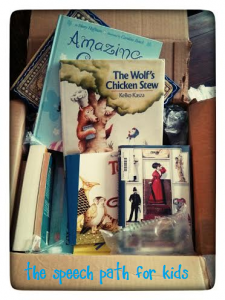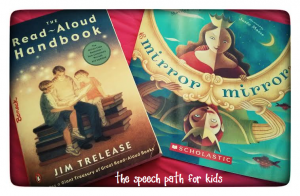This is not a well-kept secret, and a confession many of my fellow SLPs share with me…I can’t get enough of children’s literature! You may remember back in April when I shared my excitement about an Earth Day sale at Better World Books. Well, one afternoon after a long day of IEPs and medicaid documentation, they arrived on my doorstep!
It is so much fun opening a box FULL of books! Many of the stories I was unfamiliar with and chose based on SLP suggestions and TPT packets I recently purchased. I also bought several sequels of favorite chapter books for my son. I wrapped up a few books for my kids to jump-start their summer reading program that we do through our school. I already have them wrapped and sitting up on the mantle for them to open on June 2nd when the summer challenge begins. They can barely contain their excitement! Even though they figure the package has books in it, the suspense of which ones is about to drive them crazy! I love it!
One morning, one of my colleagues and I were sharing book titles that our 8 year old sons enjoy reading in order to get new ideas for the summer. She let me borrow “The Read-Aloud Handbook” by Jim Trelease. It’s a very easy read and also offers thoughtful insights about what, how, and why to read aloud to kids of all ages. I was reading it from the perspective of both an educator and a parent, and even though I consider myself seasoned at both I came away inspired with new ideas.
One section that really spoke to me as an SLP was when he explained some research done through Betty Hart and Todd Risley. Through their multi-year project titled “Meaningful Differences in the Everyday Experience of Young American Children”, they tallied and analyzed words that are spoken in the homes of professionals, working class, and those living in poverty. One similarity between all three home environments was the amount of love and positive experiences that all parents provided. A striking difference was the amount of words spoken with the child. Their research found that by age 4, the total number of words heard by children in the professional home averaged 45 million and in a working class home they have heard 26 million. Compare this to children living in poverty, who heard an average of only 13 million words in their first 4 years.
As an SLP, I am always embedding vocabulary into my lessons and conversations. I intentionally choose to use an advanced word, unfamiliar synonym, or figurative language as I chat with my students so that they can continue to expand their word knowledge. I do notice a glaring learning difference in my young students who have had more exposure to varied experiences compared to their peers who have not. Learning to read relies on background knowledge and vocabulary exposure. For students who may not be able to experience the beach or a hike through the mountains in person, stories are a valuable tool to build that vocabulary and world knowledge. This book gave me an extra boost to increase my kiddos exposure to read-aloud materials in addition to the literacy-based speech and language lessons I provide. This past week I took advantage of a few moments at the end of the session to read aloud poems from “Mirror, Mirror” and some Shel Silverstein poems. One point that Jim Trelease made that really stuck with me that once reading begins, a child’s personal vocabulary feeds (or frustrates) their comprehension of reading and classroom information. I intend to help my kiddos feel “fed” instead of “frustrated “!
If you are looking for some book ideas, the NEA has some interesting book lists here including multicultural, 50 states, kid’s top 100, and authors’ favorites. You can also read some of Jim Trelease’s suggestions on his website here. (His book suggestions was my favorite part of his book…I wrote a whole list of books for us to check out from the library this summer).
As far as collecting books for therapy (not to mention for my kids’ personal home library), I love exploring used bookstores. We spent a rainy day over spring break at a local gem. We also have a Habitat for Humanity ReStore in town that has a bookstore. You never know what you will come across because it is all built on donations. My son decided to checkout “The Boxcar Children” and at 50 cents each, that’s an easy way to try a new series! I also found some favorite authors including Rudyard Kipling, Laurie Keller, and Leo Lionni.
Have you recently added any new additions to your library? I’m always looking for suggestions! Happy reading!






